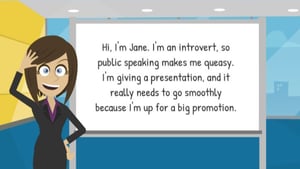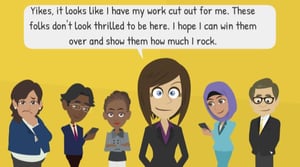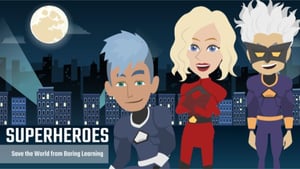Posted by Caveo Learning ● July 24, 2019
Telling Stories in Learning: Tips for Using Storytelling in Adult Learning
 Good Stories are Engaging
Good Stories are Engaging
I am a sucker for a good story. When I was a kid, I would get so immersed in a book that I would hide under my covers at night and read via flashlight.
Fast forward to adulthood, and I am a Learning Consultant who regularly uses stories in my deliverables. My hope is that a good story will captivate my audience, help content resonate, and make learning stick. Scenarios and animations are two of my favorite ways to use storytelling in adult learning.
 Good Stories are Relatable
Good Stories are Relatable
Tailor your story to your audience members by creating characters that are relatable. When a learner can relate to a character, they will feel better connected and develop an understanding of the experience of your character.
Good Stories are Conversational
Write dialogues that are conversational in tone, using language that your learners would actually say to a coworker. Consider using contractions and slang to help make the conversation more authentic. Make sure to use acronyms and terms that employees say within the organization. Read your dialogues out loud to confirm they sound like natural conversation.
 Good Stories are Personal
Good Stories are Personal
Do not be afraid to share personal stories that include failures and lessons learned. Personal stories that come from the heart tend to resonate with learners and give them a safe space to learn what to do (or not to do). After all, it is safer—and much more fun—to learn from the mistakes of others than it is to fail by yourself.
Good Stories are Memorable
Start by coming up with a strong hook and ending, then focus on storyboarding the various elements that will help make your story memorable. Add conflict to make your characters human. Think about how you will visually depict your story. Determine whether you will tell you story all at once or weave it throughout the learning deliverable.
Good Stories are Simple
Read and reread your story, editing yourself along the way. Ask others to review your story and help tweak it to make it simple yet engaging, relatable, conversational, personal, and memorable.
 Good Stories are Fun
Good Stories are Fun
Consider centering your story around a theme, such as superheroes. Have fun creating learning activities that tie back to your theme. For example, provide badges (such as superhero powers or a cape) for successfully completing knowledge checks, and use villains to give negative feedback when learners answer questions incorrectly. When you have fun telling your story, learners will enjoy completing your training.
Topics: Instructional Design

